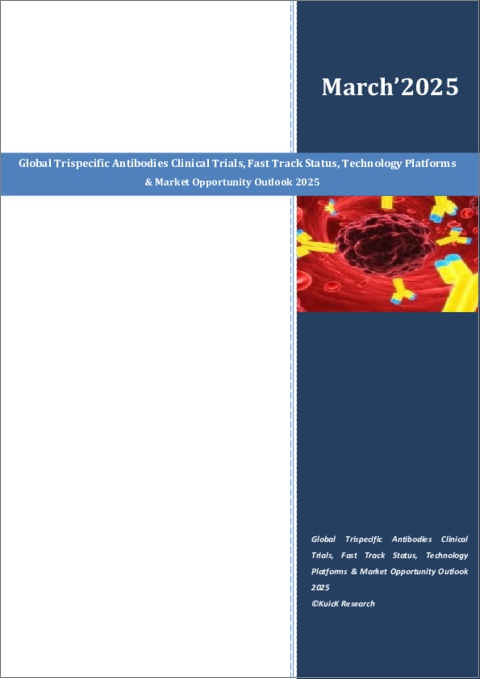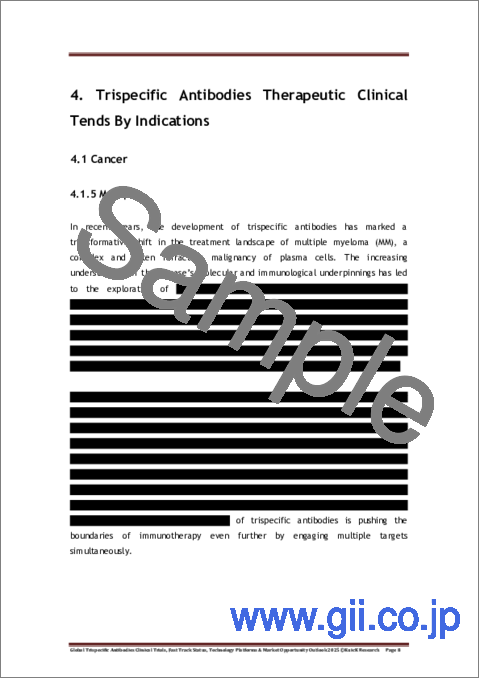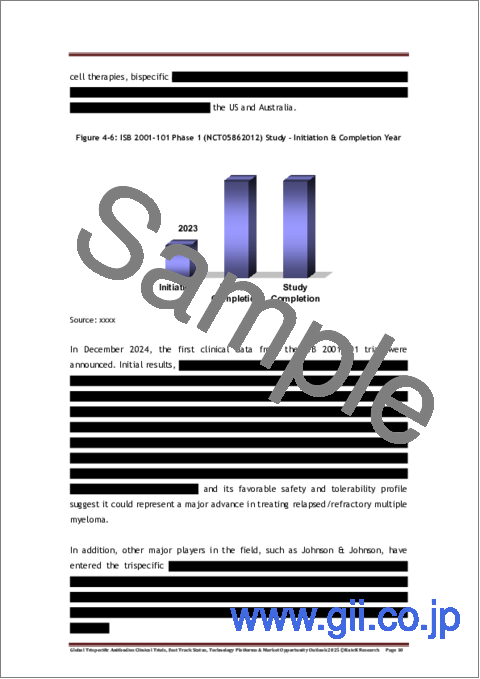|
|
市場調査レポート
商品コード
1681034
三重特異性抗体の世界市場:臨床試験、ファストトラックの現状、技術プラットフォームと市場機会の展望(2025年)Global Trispecific Antibodies Clinical Trials, Fast Track Status, Technology Platforms & Market Opportunity Outlook 2025 |
||||||
|
|||||||
| 三重特異性抗体の世界市場:臨床試験、ファストトラックの現状、技術プラットフォームと市場機会の展望(2025年) |
|
出版日: 2025年03月01日
発行: KuicK Research
ページ情報: 英文 150 Pages
納期: 即日から翌営業日
|
全表示
- 概要
- 図表
- 目次
三重特異性抗体市場は、多特異性抗体研究の継続的な進歩に大きく後押しされ、バイオ医薬品における有望かつダイナミックな分野として浮上してきました。モノクローナル抗体と二特異性抗体の成功は、免疫療法における次世代の革新である三重特異性抗体の開発の基礎を築いた。これらの三重特異性抗体は、3つの異なる抗原を標的とし、モノクローナル抗体や二特異性抗体と比較して、治療の可能性を高めています。三重特異性抗体はいずれもまだ承認されていないが、いくつかの候補は開発が進んでおり、一部は第II/III相臨床試験中で、近い将来承認される可能性を示しています。
現在、大小を問わず多くの企業が三重特異性抗体の開発に力を注いでおり、多くの場合、他の組織と協力してリソースや専門知識を共有しています。例えば、2025年1月、AbbVie とSimcere Zaimingとは、GPRC5D、BCMA、CD3を標的とするヒト化三重特異性抗体SIM0500の開発に関するオプション・トゥ・ライセンス契約を締結しました。この抗体は現在、米国と中国で再発または難治性の多発性骨髄腫(MM)患者を対象とした第I相臨床試験中です。本契約に基づき、Simcere ZaimingはAbbVieから契約一時金と、本プログラムの成功次第で総額10億5,500万米ドルに達するマイルストーンとオプション料を受け取ることになります。
三重特異性抗体は有望な前臨床試験結果を示しており、しばしば従来の治療法を凌駕しています。その顕著な例が、Ichnos Glenmark Innovationが開発したBCMA/CD38/CD3三重特異性抗体であるISB 2001です。JanssenのテクバイリやBristol Myers Squibbのアルヌクタマブ候補のような二特異性抗体とヒト細胞株で比較試験したところ、ISB 2001は20倍から260倍のがん殺傷力を示しました。さらに、ISB 2001は多発性骨髄腫患者の腫瘍を除去する能力において、テクバイリよりも優れていることが証明されました。動物モデルでは、ISB 2001は低用量で投与した8匹のマウスすべてで腫瘍を完全に消失させたのに対し、Tecvayliは30.8%の腫瘍増殖抑制効果しか示しませんでした。これらの有望な結果は、既存の治療法と比較して、三重特異性抗体の治療可能性が強化されていることを強調するものです。
三重特異性抗体の新たな臨床試験が続々と登場し、がん治療やそれ以外の分野での期待がさらに高まっています。例えば、2025年3月、CStone Pharmaceuticalsは、新規PD-1/VEGF/CTLA-4三重特異性抗体CS2009の国際多施設共同第I相臨床試験において、最初の患者の投与に成功したと発表しました。初期の報告によると、輸液反応やその他の有害事象は認められず、この先進的治療薬の安全性プロファイルのさらなる証拠となっています。これらの臨床試験が進むにつれて、三重特異性抗体の市場は拡大し、従来の治療法に抵抗性が証明されたがんやその他の疾患の患者に新たな選択肢を提供することになるとみられています。
楽観的な見通しとは裏腹に、三重特異性抗体の開発にはいくつかの課題があります。製造の複雑さと、複数の抗原を正確にターゲティングする必要性は、重要なハードルのひとつです。三重特異性抗体治療を成功させるには、効果的でスケーラブルな製造プロセスの開発が不可欠です。さらに、規制上の課題、特に安全性と有効性のデータという点で、これらの革新的治療法の承認への道は遅れるかもしれません。
とはいえ、三重特異性抗体市場は、より標的を絞った効果的ながん治療に対する需要の高まりや、抗体工学や生産技術の進歩などの要因により、成長を続けています。二重特異性抗体の成功例が増えていることに加え、三重特異性抗体の可能性を示す臨床試験の数が増加していることから、この市場への投資や関心がさらに高まることが予想されます。その結果、三重特異性抗体市場は今後数年間で大きな成長が見込まれ、より多くの共同研究、臨床試験、そして潜在的な市場承認がこの有望な新クラスの治療薬に道を開くことになると予測されています。
当レポートは、世界の三重特異性抗体市場について調査し、市場の概要とともに、薬剤動向、臨床試験動向、地域別動向、および市場に参入する企業の競合情勢などを提供しています。
目次
第1章 標的治療としての三重特異性抗体
第2章 三重特異性抗体- 現在の臨床開発と将来の商業化の展望
- 現在の市場開拓シナリオ
- 将来の市場商業化の見通し
第3章 地域別の三重特異性抗体の臨床および市場開拓動向分析
- 米国
- 中国
- EU
- 英国
- 日本
- オーストラリア
第4章 三重特異性抗体の治療的臨床傾向、適応症別
- がん
- 乳がん
- 大腸がん
- 肺がん
- 脳腫瘍
- 多発性骨髄腫
- リンパ腫
- 白血病
- ウイルス感染
- 眼科疾患
- 自己免疫疾患および炎症性疾患
第5章 企業、国、適応症、相別の世界三重特異性抗体臨床試験の洞察
- 研究
- 前臨床
- 第I相
- 第I/II相
- 第II/III相
第6章 世界の三重特異性抗体市場力学
- 市場の促進要因
- 市場の課題
第7章 三重特異性抗体市場の最近の動向:提携、買収、コラボレーション、投資
第8章 成長中の三重特異性抗体に対する組み合わせアプローチ
- 免疫療法
- 放射線治療
第9章 三重特異性抗体の先駆的開発に使用されたプラットフォーム
第10章 競合情勢
- Antibody Studio
- BeiGene
- Beijing Mabworks Biotech
- Biocytogen Pharmaceuticals
- Candid Therapeutics
- Chimagen Biosciences
- Chiome Bioscience
- Chugai Pharmaceutical
- Eluminex Biosciences
- Genor Biopharma
- Harpoon Therapeutics
- Ichnos Glenmark Innovation
- KisoJi Biotechnology
- L and L Biopharma
- Lyvgen Biopharma
- Numab
- OPKO Health
- Sanofi
- Shine-On
- Zymeworks
List of Figures
- Figure 1-1: Trispecific Antibody As Targeted Therapy
- Figure 2-1: Strategies To Develop Next Generation Trispecific Antibody
- Figure 2-2: Aspects Influencing Future Of Trispecific Antibody
- Figure 3-1: POTENTIA Phase 1 (NCT04839991) Study - Initiation & Completion Year
- Figure 3-2: SAL101JG Phase 1 Study (NCT05735366) - Initiation & Completion Year
- Figure 4-1: NM32-2668 Phase 1 Study (NCT06299163) - Initiation & Completion Year
- Figure 4-2: MK-6070-001/HPN328-4001 Phase 1/2 (NCT04471727) Study - Initiation & Completion Year
- Figure 4-3: MK-6070-002 Phase 1/2 MK-6070-002 (NCT06780137) Study - Initiation & Completion Year
- Figure 4-4: GB263T-FIH001 Phase 1/2 Study (NCT05332574) - Initiation & Completion Year
- Figure 4-5: SIM0500-101 Phase 1 (NCT06375044) Study - Initiation & Completion Year
- Figure 4-6: ISB 2001-101 Phase 1 (NCT05862012) Study - Initiation & Completion Year
- Figure 4-7: CR109234 Phase 1 (NCT05652335) Study - Initiation & Completion Year
- Figure 4-8: JNJ-79635322 Phase 1 (NCT06768489) Study - Initiation & Completion Year
- Figure 4-9: Multiple Myeloma - Trispecific Antibodies With Regulatory Designations
- Figure 4-10: CPIT565A12101 Phase 1 (NCT05397496) Study - Initiation & Completion Year
- Figure 4-11: CR109174 Phase 1 (NCT05424822) Study - Initiation & Completion Year
- Figure 4-12: JNJ-80948543 Phase 2 (NCT06660563) Study - Initiation & Completion Year
- Figure 4-13: JNJ-80948543 Phase 1 (NCT06139406) Study - Initiation & Completion Year
- Figure 4-14: AZD5492 Phase 1/2 (NCT06542250) Study - Initiation & Completion Year
- Figure 4-15: Restoret - Structure
- Figure 4-16: BRUNELLO Phase 2/3 (NCT06571045) Study - Initiation & Completion Year
- Figure 4-17: Ophthalmic Diseases - Eluminex Ophthalmics Trispecific Antibody Candidates
- Figure 4-18: CPIT565B12101 Phase 1 (NCT06335979) Study - Initiation & Completion Year
Figure 6-1 : Trispecific Antibody - Market Drivers
- Figure 6-2: Trispecific Antibody - Market Challenges
- Figure 9-1: Chugai Pharmaceutical - Dual-Ig Platform
- Figure 9-2: Mab Works - Multispecific Antibody Platform
- Figure 9-3: DARPin Platform - Molecular Partners
- Figure 9-4: Merus - Triclonics Platform
- Figure 9-5: Purple Biotech - Tribody Antibody Platform
- Figure 9-6: Shine-On BioMedical - Trispecific T Cell Engager Antibody
- Figure 9-7: Zymeworks Azymetric
List of Tables
- Table 3-1: US - Ongoing Clinical Trials For Trispecific Antibodies
- Table 3-2: EU - Ongoing Clinical Trials For Trispecific Antibodies
- Table 3-3: Australia -Ongoing Clinical Trials For Trispecific Antibodies
Global Trispecific Antibodies Clinical Trials, Fast Track Status, Technology Platforms & Market Opportunity Outlook 2025 Report Findings & Highlights:
- First Trispecific Antibody Commercial Approval Expected By 2028
- Currently More Than 50 Trispecific Antibodies Are Under Clinical Trials
- Report Includes Clinical Trials Insight On More Than 50 Trispecific Antibodies By Company, Country, Indication & Phase
- China & USA Dominating Trispecific Antibody Research
- Highest Phase Of Development: Phase II/III
- Insight On Platforms Used For Pioneering Trispecific Antibody By Companies
- Trispecific Antibodies Therapeutic Clinical Tends By Region & Indications
- Insight On 20 Key Companies Developing Trispecific Antibodies
The trispecific antibody market has emerged as a promising and dynamic field in biopharmaceuticals, driven largely by ongoing advancements in multispecific antibody research. The success of monoclonal and bispecific antibodies has laid the foundation for the development of trispecific antibodies, a next-generation innovation in immunotherapy. These trispecific antibodies target three distinct antigens, enhancing their therapeutic potential in comparison to their monoclonal and bispecific counterparts. While none of the trispecific antibodies have yet gained approval, several candidates are in advanced stages of development, with some in Phase II/III clinical trials, indicating a potential for approval in the near future.
Many companies, both large and small, are now focusing their efforts on the development of trispecific antibodies, often collaborating with other organizations to pool resources and expertise. For instance, in January 2025, AbbVie and Simcere Zaiming entered into an option-to-license agreement for the development of SIM0500, a humanized trispecific antibody targeting GPRC5D, BCMA, and CD3. This antibody is currently undergoing Phase I clinical trials in the US and China for patients with relapsed or refractory multiple myeloma (MM). Under the agreement, Simcere Zaiming stands to receive an upfront payment from AbbVie, in addition to milestone payments and option fees that could total up to US$ 1.055 Billion, depending on the success of the program.
Trispecific antibodies have demonstrated promising preclinical results, often outperforming traditional therapies. A notable example is ISB 2001, a BCMA/CD38/CD3 trispecific antibody developed by Ichnos Glenmark Innovation. When tested against bispecific antibodies like Janssen's Tecvayli and Bristol Myers Squibb's candidate alnuctamab in human cell lines, ISB 2001 showed a 20- to 260-fold stronger cancer-killing potency. Furthermore, ISB 2001 proved superior to Tecvayli in its ability to eliminate tumors from multiple myeloma patients. In animal models, ISB 2001 completely eradicated tumors in all eight mice treated with a low dose, whereas Tecvayli showed limited efficacy, with only a 30.8% tumor growth inhibition. These promising results highlight the enhanced therapeutic potential of trispecific antibodies in comparison to existing therapies.
New clinical trials for trispecific antibodies continue to emerge, further solidifying their promise in cancer treatment and beyond. For instance, in March 2025, CStone Pharmaceuticals announced the successful dosing of the first patient in a global multicenter Phase I clinical trial of CS2009, a novel PD-1/VEGF/CTLA-4 trispecific antibody. Early reports indicate that no infusion reactions or other adverse events were observed, providing further evidence of the safety profile of these advanced therapeutics. As these trials progress, the market for trispecific antibodies will likely expand, offering new options for patients with cancer and other conditions that have proven resistant to conventional therapies.
Despite the optimistic outlook, there are several challenges facing the development of trispecific antibodies. The complexity of manufacturing and the need for precise targeting of multiple antigens are among the key hurdles. The development of effective and scalable manufacturing processes will be crucial to ensuring the success of trispecific antibody therapies. Additionally, regulatory challenges, particularly in terms of safety and efficacy data, may slow the path to approval for these innovative treatments.
Regardless, the market for trispecific antibodies continues to grow due to factors such as the growing demand for more targeted and effective cancer therapies, as well as advancements in antibody engineering and production technologies. The increasing success of bispecific antibodies, combined with the growing number of clinical trials demonstrating the potential of trispecifics, is likely to drive further investment and interest in this market. As a result, the trispecific antibody market is expected to see significant growth in the coming years, with more collaborations, clinical trials, and potentially, market approvals paving the way for this promising new class of therapeutics.
Table of Contents
1. Trispecific Antibody As Targeted Therapy
2. Trispecific Antibody - Current Clinical Development & Future Commercialization Outlook
- 2.1 Current Market Development Scenario
- 2.2 Future Market Commercialization Outlook
3. Trispecific Antibody Clinical & Market Development Trend Analysis By Region
- 3.1 US
- 3.2 China
- 3.3 EU
- 3.4 UK
- 3.5 Japan
- 3.6 Australia
4. Trispecific Antibodies Therapeutic Clinical Tends By Indications
- 4.1 Cancer
- 4.1.1 Breast Cancer
- 4.1.2 Colorectal Cancer
- 4.1.3 Lung Cancer
- 4.1.4 Brain Cancer
- 4.1.5 Multiple Myeloma
- 4.1.6 Lymphoma
- 4.1.7 Leukemia
- 4.2 Viral Infections
- 4.3 Ophthalmic Diseases
- 4.4 Autoimmune & Inflammatory Diseases
5. Global Trispecific Antibodies Clinical Trials Insight By Company, Country, Indication & Phase
- 5.1 Research
- 5.2 Preclinical
- 5.3 Phase I
- 5.4 Phase I/II
- 5.5 Phase II/III
6. Global Trispecific Antibody Market Dynamics
- 6.1 Market Drivers
- 6.2 Market Challenges
7. Recent Trends In Trispecific Antibody Market: Partnerships, Acquisitions, Collaboration, & Investments
8. Combinations Approaches For Bourgeoning Trispecific Antibody
- 8.1 Immunotherapy
- 8.2 Radiotherapy
9. Platforms Used For Pioneering Trispecific Antibody
- 9.1 Chugai Pharmaceutical - Dual-Ig Platform
- 9.2 Ichnos Sciences - BEAT Platform
- 9.3 Mab Works - Multispecific Antibody Platform
- 9.4 Molecular Partners - DARPin Platform
- 9.5 Merus - Triclonics Platform
- 9.6 Purple Biotech - Tribody Antibody Platform
- 9.7 Shine-On BioMedical - Trispecific T Cell Engager Antibody
- 9.8 Simcere Zaiming - T-Cell Engager Polyspecific Antibody Technology Platform
- 9.9 Tavotek Biotherapeutics - TavoSelect & TavoPrecise Platforms
- 9.10 Zymeworks - Azymetric
10. Competitive Landscape
- 10.1 Antibody Studio
- 10.2 BeiGene
- 10.3 Beijing Mabworks Biotech
- 10.4 Biocytogen Pharmaceuticals
- 10.5 Candid Therapeutics
- 10.6 Chimagen Biosciences
- 10.7 Chiome Bioscience
- 10.8 Chugai Pharmaceutical
- 10.9 Eluminex Biosciences
- 10.10 Genor Biopharma
- 10.11 Harpoon Therapeutics
- 10.12 Ichnos Glenmark Innovation
- 10.13 KisoJi Biotechnology
- 10.14 L and L Biopharma
- 10.15 Lyvgen Biopharma
- 10.16 Numab
- 10.17 OPKO Health
- 10.18 Sanofi
- 10.19 Shine-On
- 10.20 Zymeworks






